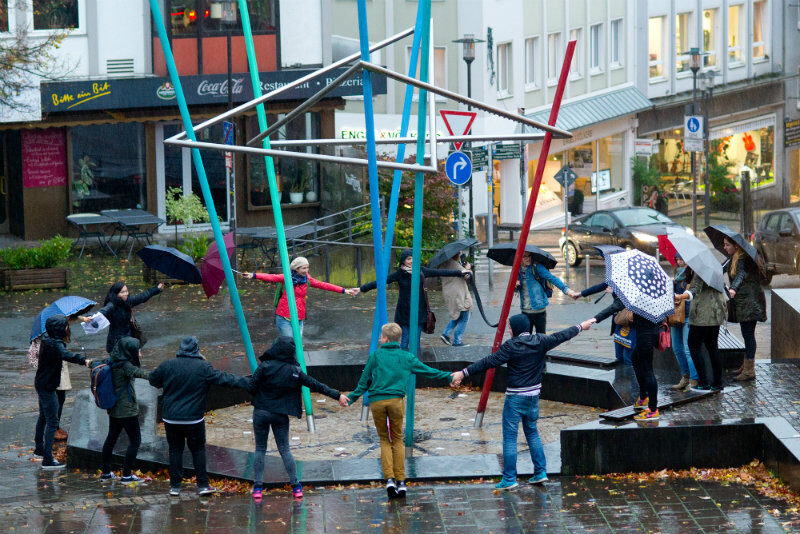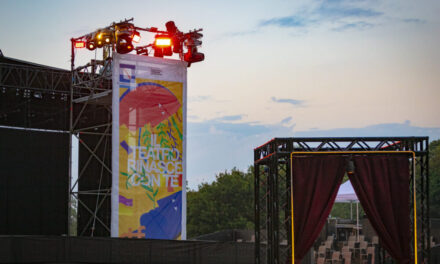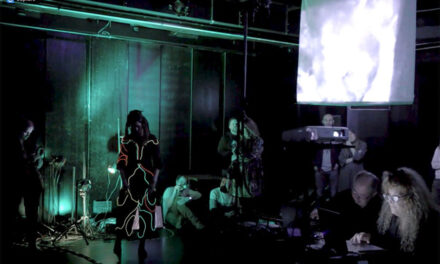Professor Judith Ackermann studied media, psychology, and computer linguistics prior to taking up acting for a time after growing tired of so much theoretical study. Nonetheless, she also decided to pursue her PhD in parallel with her acting studies, but this simply took too much time. Ackermann then dedicated herself to her doctoral studies.
How did you come to research pervasive games?
I was researching computer games and started to focus on LAN-parties for my PhD studies. Three groups of gamers played for 6 hours each and I recorded, then transcribed, what they said. I analysed how the communication between gamers happened, to see how social it was are and how many different topics were coming up. Even when the participants were playing a shooter game, they had a sense of collectiveness even though they didn’t know one another before. As I was also working in theatre at the time, I found that there are many parallels between acting and digital games: both evolve while you’re playing and there is always someone who is observing you. The actor-spectator relationship might even be personified in only one person. It’s a core specific of theatre, liveness and co-presence. This is how I started to look at both fields. In 2011, I did my first panel on the combination of these elements. I’m not so much working with the concept of ‘theatralität’ as I am with performance – based on Erika Fischer-Lichte’s writings. I was also very much inspired by Sybille Krämer’s work, especially by her theory of corporealising performativity. At the time, she was also writing books on mediatisation and performativity, and especially about the separation of the body into ‘sign body‘ and ‘flesh body‘ while playing computer games.
You developed the hybrid-reality-theatre concept?
Yes, it is a complex concept: I came up with the idea while looking at location-based mobile games which are happening in the urban scene, and are also seen or observed by persons who are not participating – at first – in the gaming action. They see that something is happening which is not normal for the city given what they have learned about how to behave at certain spots, like how one may be allowed to walk and look in the windows, but not be allowed to loiter in one locale. People who are not engaged in gaming activities, perceive this as someone behaving in a different way which is suspicious. In the case of location based media performances, the ‘observers’ cannot perceive what is happening in the digital sphere because they can only see one-half of the performance. But it has a performative quality and that gets people’s attention: they become spectators, which in turn affects the game players. They are aware of being observed and of how others react to them. It is the classic autopoietic feedback loop that we know from theatre performance – enriched with (partially visible) digital actions. This is why it is called ‘hybrid reality theatre’.. As Adriana de Souza e Silva puts it, in the hybrid reality you have a simultaneity of digital and physical action that is combined via movement. This is what is happening in location-based games: you are on the move with your mobile game and all the actions are done in physical space. These are transferred to digital action and they influence each other. At the same time, I also started to look at other forms of digital games, asking if these things were also happening in classic computer games. I came to the idea that it is the same: you have the combination of one person being both the spectator and the actor at the same moment. This is possible because you are always monitoring what you are doing in the game, and although you are ‘moving’ in a limited physical space – you are more or less clicking or moving only a little bit with your controller – you are moving inside your digital sphere. I would depart a bit from Adriana de Souza e Silva’s idea that you have to have a motion in physical space, and add that it can accomplish the same with digital motion. This can also be enough to be called hybrid reality.
You also include avatars in this concept? Do these also belong to hybrid reality?
Yes, because players are also interacting with the avatars and also observing them. Sometimes this is pretty visible. There are fighter games like eye toy Virtual Fighter where you find yourself transformed into a digital avatar, and you have to fight against some other avatars. You see yourself acting and are thereby increasing the performance aspect of it. This shows how the roles can be merged together.
Why do you think urban games are so often included in theatre festival programs?
Because the similarities are quite visible. You have the costume aspect of it and you have very high visibility, which means there is something extraordinary happening. My colleague Ilaria Mariani and I did urban games in Milan and found that having the costume and mask effect in urban games leads people to perform in an awkward way in their space. In a theatre performance, when the actor is bowing, you think that you see the person behind the role. This is about stepping out from the ritual. I like the words of Klaus Lazarowicz: intra-theatrical communication is pointing out the different roles of actor, spectator, creator and all the different parts they play. The audience has the knowledge that the actor, at some moment, is not himself or herself but the role, and that this ends when he or she bows. I used this thinking in developing my concepts and transformed them for game designers, spectators, and player actors. You can have all the roles in one person, but you can also play the game when there are real people who are observing. I really like his work.
It will be great, I hope so. Digital media will be naturally integrated. The similarities are becoming more and more visible. VR-performance will be more coherent and we‘ll see if computer gamers will have a way back to theatre via urban gaming (or technically mediated performances, that are transforming this older media form).
Do you think that gamers will want to go to theatre more often?
It is already happening. I see a tendency for creating formats that merge games and theatre: this is a subtle way of familiarizing people with both spheres. That way, people who don’t think that they want to go to the theatre at first, can get there via gaming. This is happening, for example, at conferences and meetings like this, the Next Level Festival. The Next Level Festival is pretty unique and is not characteristic for Germany. This is the seventh time it has been held and the performance part has broadened every time. The Festival is moving through North Rhine-Westphalia, and a way to promote innovative games. Still, the Next Level Festival is pretty unique and not a not typical German approach to games and theatre. We are still at the beginning, but for those of us who are familiar with the topic, it seems as if the field has largely increased. Still, this might not actually be the case.
Do you think that the new technological tools that are being used in performances are changing interactivity?
I do think that the increasing familiarity and equipment with digital media and its interactive possibilities has already started to alter people’s attitude towards theatre and performance and their readiness to engage in participative activities. On the other hand, the existing knowledge about the various technological tools and their areas and ways of application, allows for artistic experimentation, pushing the envelope. Results of these activities for sure can affect technological developments and thereby influence notions of interactivity. It is a self-reinforcing process.
Interview made at Next Level Festival in Düsseldorf, November 2016.
This article was originally published in the ZipScene Magazine. Reposted with permission. Read the original article.
This post was written by the author in their personal capacity.The opinions expressed in this article are the author’s own and do not reflect the view of The Theatre Times, their staff or collaborators.
This post was written by Ágnes Bakk.
The views expressed here belong to the author and do not necessarily reflect our views and opinions.

















